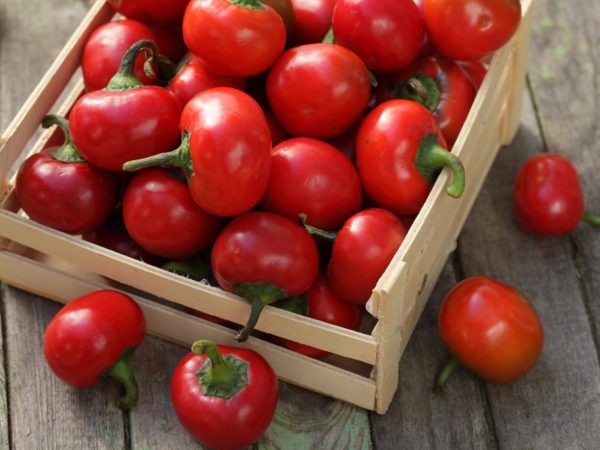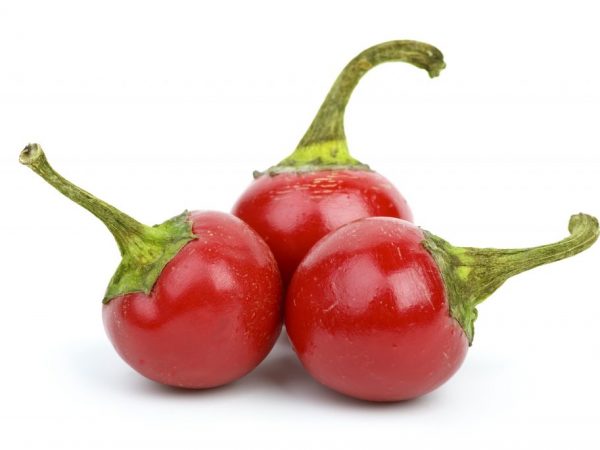Characteristics of Gogoshary pepper
Gogoshary pepper is a variety that was bred by Moldovan breeders. Refers to tomato plants.

Gogoshary pepper
Gogoshary combines many varieties of round peppers. They are all alike. May vary slightly in shape and taste. But they are grown and looked after in the same way.
Description
The variety is mid-season. After the emergence of full shoots, it takes about 110 days to the technical phase of fruit ripening. These types of vegetables are also called "Ratunda". It is under this name that you should look for it in stores.
Gogoshara pepper varieties:
- Ratunda
- Ruby 2;
- Merishore;
- Olenka;
- Gogoshar is local;
- Hybrid Sweetie;
- Olenka's hybrid;
- Golden Jubilee;
- Apple Spas;
- Golden Tamara.
It is necessary to grow in places far from the growth of bitter and sweet peppers. After all, the culture is easily pollinated and can acquire an unusual taste. The site must be lighted and protected from winds and drafts. Good precursors for peppers are beets, cucumbers, onions, and carrots. The bad ones are potatoes and tomatoes, because plants are affected by the same diseases that persist in the soil.
The soil for cultivation should be light and loose, permeable to water. The best choice would be loam with the addition of humus. Grown in open and closed ground.
Description of the bush
The plant is standard, down-to-earth. It is small in size: the height of the bush reaches 50 cm, width - 45 cm. The leaves are rounded, pointed at the tips. Their color is dark green. Due to its small growth, the crop is best grown in greenhouses and film tunnels.
Description of the fetus
The peppers are round in shape, flattened, resembling balls or small pumpkins. Large - weight is 50-130 g. They have 4 ribbed chambers. Wall thickness 7 mm. Vegetables, depending on the type, can be of different colors: green, yellow, red. For some, it is unusual: purple, burgundy, black. Thanks to the powerful stalk, many vegetables are directed upwards. The pulp is dense, juicy, fleshy. The taste is sweet, there is no bitterness. Used fresh and processed.
Advantages and disadvantages
The Gogoshary pepper variety has a number of positive characteristics:
- high productivity;
- the meatiness of the fruit;
- good preservation;
- transportability;
- low calorie content;
- usefulness - contains vitamins of group B, PP, C and many microelements;
- the ability to ripen in a torn camp.
There are also disadvantages: it does not tolerate drought, it is susceptible to some diseases and pests. You must be extremely careful with the stems, because they are very fragile.
Care

Pepper needs care
Gogoshary pepper requires optimal growing conditions. They are the key to a high yield.
Seedling care
The plant is cultivated by seedling method. To grow strong and healthy seedlings, you need to properly care for them. This process includes the following activities:
- watering;
- loosening;
- dive;
- top dressing;
- ensuring the appropriate temperature and illumination.
Watering
Watering is done often, but in moderation, when the topsoil dries out. The water should be warm, settled.
Loosening
Loose ones must be carried out very carefully so as not to catch the roots. It is not done if the sprouts are less than 1-2 cm.
Picking
Gogoshary pepper belongs to those plants that require picking of seedlings. It is produced when the sprouts have 2-3 true leaves. This process is important as the plant develops a strong root system. Care must be taken not to damage the sensitive roots.
Top dressing
Fertilize seedlings 12-14 days after germination. For this purpose, liquid complex fertilizers are used. They are used strictly according to the instructions.
Temperature regime
The description says that the seedlings must be grown in a warm place, because Gogoshara pepper belongs to the plants that love it very much. Seedlings germinate at 25-26 ° C, then the indicators can be maintained at the level of 18-22 ° C. The temperature is lowered gradually so that there are no sudden changes. Otherwise, the seedlings may slow down their growth or completely die. Seedlings must be hardened two weeks before planting. To do this, containers with them are taken out into the street in a shaded place for 1-2 hours every day.
Leaving after disembarkation
To prevent the culture from dropping ovaries and flowers, it is necessary to prevent the drying of the soil. You need to moisturize it regularly. Warm water can also be applied between the rows to increase humidity.
It is imperative to loosen the soil, but be careful not to damage the roots, because they are located shallow. Instead of loosening, mulching can be done. Straw, sawdust, dried grass are used as mulch. Lay a layer of 2-3 cm.
It is also worth periodically weeding. Weeds are pulled out only in the aisles; this should not be done near the roots.
The description of the variety says that Gogoshary pepper needs high-quality feeding. It is carried out in 3 stages:
- after disembarking to a permanent place;
- during the flowering period;
- during the appearance of fruits.
Fertilized with nitrogen, complex, phosphorus agents. The dosage must be determined strictly according to the instructions so as not to harm the roots of sweet pepper.
The plant requires a garter, because the fruits are quite large. They heavily load the bush. When plucking vegetables, you need to hold the stalk so as not to damage the whole bush. The first vegetables are harvested when they are in the technical maturity phase.
Diseases and pests
Since this type of bell pepper is susceptible to disease, preventive measures or treatment should be carried out if necessary. The culture is affected by rot of various types, fungi, Colorado beetles, slugs, aphids. Because of them, sweet peppers slow down their growth or die.
Correct conduct of agrotechnical processes will be a good prevention of diseases. Also, after harvesting, all plant residues are removed from the site. Before planting seeds, they are pickled.
From organic agents, ash and chalk are used. They are periodically powdered with sweet peppers.
For medicinal purposes, they are sprayed with insecticides. Processing is done 2-3 times per season with an interval of 3 weeks. For fungal diseases, 1% Bordeaux liquid is used. Before flowering, they are sprayed with Oxyhom: 2 tablets are given per 10 liters of water. Infected fruits are burned or buried.
Slugs and beetles can be hand picked. Eggs of pests are also destroyed.
Conclusion
Gogoshary peppers are of interest to summer residents for their unusual shape. Proper care will ensure a bountiful and healthy harvest. Large, fleshy fruits have a pleasant taste and are a source of many vitamins.


